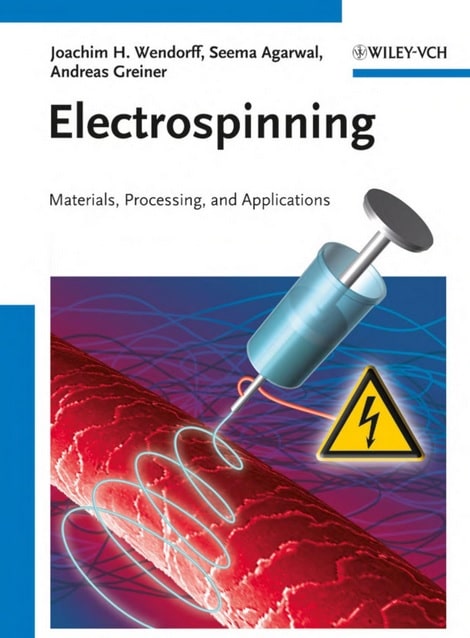
Contents
Preface IX
1 Introduction 1
1.1 Fibers – Key Functional Elements in Technology and Nature 1
1.2 Some Background Information 4
1.2.1 Structure of Crystalline and Amorphous Materials 4
1.2.2 Chain Conformation and Structures of Polymer Materials 7
1.3 Processing of Polymer Materials towards Fibers – Fiber Extrusion 10
1.4 Routes to More Advanced Fibers – Mimicking Nature 12
1.5 Electrospinning 16
1.5.1 A Simple Experimental Approach 16
1.5.2 The Hidden Physical Complexity 20
1.5.3 Short History of Electrospinning – The Routes Go Back More Than Two
Centuries 22
1.6 Electrospinning – Important Facts to Remember 24
References 26
2 Nature of the Electrospinning Process – Experimental Observations and
Theoretical Analysis 29
2.1 Experimental Setups 29
2.2 Experimental Observations on Fiber Formation 33
2.2.1 Droplet Formation at the Tip of the Die 34
2.2.2 The Straight Path of the Jet 36
2.2.3 The Looping Part of the Jet – Onset of Bending Instabilities 40
2.2.4 The Deposition Process 42
2.3 Theoretical Analysis of the Nature of the Electrospinning
Processes 45
2.3.1 Droplet Deformation and Onset of Jetting 46
2.3.2 Linear Path of the Jet 52
2.3.3 The Path of the Jet Submitted to Bending 55
2.3.4 Deposition on a Substrate 59
2.3.5 Onset of Further Instabilities 60
2.3.6 Branching Processes 66
2.4 Nature of the Electrospinning Process – Important Facts to
Remember 66
References 67
3 Nanofi ber Properties 69
3.1 Parameters Controlling Nanofi ber Formation 69
3.2 Short Account on Methods of Analysis for the Structure of Electrospun
Nanofi bers 72
3.2.1 Analysis of Fiber Geometry and Topology 72
3.2.2 Analysis of the Internal Fiber Morphology 76
3.3 Control of Nanofi ber Diameters 78
3.3.1 The Feeding Rate 78
3.3.2 Concentration of Polymer Spinning Solution 80
3.3.3 Electrical Parameters: Applied Voltage, Electrode Distance,
Conductivity 83
3.3.4 Additional Factors 84
3.3.5 Mixtures of Solvents/Nonsolvents 84
3.4 Shape of the Fibers 84
3.5 Nanofi ber Topologies, Porous Fibers 88
3.6 Nanofi ber Trajectories in the Deposition Plane 92
3.7 Internal Morphology of Electrospun Nanofi bers 96
3.7.1 Amorphous Polymers 97
3.7.2 Partial Crystalline Nanofi bers 99
3.8 Mechanical Properties of Single Nanofi bers 101
3.9 Nanofi ber Properties – Important Facts to Remember 103
References 103
4 Nonwovens Composed of Electrospun Nanofi bers 105
4.1 Nanofi ber Nonwovens – Functional Elements for Technical
Applications 105
4.2 Methods of Analysis for Properties on Nonwovens 106
4.2.1 Nonwoven Architecture and Total Porosity 106
4.2.2 Analysis of Pore Sizes 107
4.2.3 Internal Specifi c Surface and Permeation Coeffi cient 108
4.2.4 Permeation Coeffi cient 109
4.3 Fiber Arrangements in Nonwovens 109
4.4 Heterogeneous Nonwovens 112
4.5 Porosity and Pore Structures – Theoretical Modeling and Experimental
Analysis 113
4.5.1 Prediction of Monte Carlo Simulations 114
4.5.2 Experimental Results 117
4.5.3 Nonwoven with Unimodal Fiber Diameter Distribution 117
4.5.4 Comparisons of Experimental Results with Theoretical
Predictions 122
4.6 Mechanical Properties of Nonwovens 124
4.7 Nonwovens Composed of Electrospun Nanofi bers – Important Facts to
Remember 125
References 126
5 Electrospinning – Some Technical Aspects 127
5.1 Technical Setups for Creating Jets 127
5.1.1 Some Technical Details 129
5.1.1.1 The Die 129
5.1.2 High-Voltage Supply 130
5.1.3 Counterelectrode 131
5.1.4 Spinning Chamber 131
5.1.5 Multiple-Die Setups 132
5.1.6 Die-Free Multiple-Jet Injection 133
5.2 Designs of Counterelectrode Confi gurations Allowing Preparation of
Nonwovens with a Broad Range of Architecture 137
5.3 Electrospinning – Some Technical Aspects – Important Facts to
Remember 141
References 142
6 Modifi cation of the Electrospinning Technique 143
6.1 Towards Advanced Modes of Fiber Preparation and Deposition 143
6.2 Near-Field Electrospinning – High-Precision Deposition
Electrospinning 144
6.2.1 Deposition of Individual Fibers 148
6.2.2 Deposition of Nonwoven Test Pattern 151
6.2.3 Deposition of Precision Nonwovens Paths 151
6.3 Towards Core–Shell and Hollow Fibers 155
6.3.1 Coelectrospinning/Coaxial Electrospinning 155
6.3.2 Core–Shell Fibers and Hollow Fibers via a Template (TUFT
Approach) 160
6.3.3 Background Information 160
6.4 Modifi cation of the Electrospinning Technique – Important Facts to
Remember 162
References 163
7 Materials Considerations 165
7.1 Introduction 165
7.1.1 Background Information 166
7.1.1.1 Solutions and Dispersions 166
7.1.1.2 Bioerodible and Biostable Polymers 166
7.2 Spinning from Organic Solvents 166
7.3 Spinning of Water-Soluble Polymers 170
7.4 Spinning of Biopolymers 172
7.5 Spinning of Complex Polymer Systems 175
7.5.1 Background Information 175
7.6 Nanofi bers from Polymer Hybrids, Metals, Oxides 178
7.7 Melt Spinning 180
7.8 Materials Considerations – Important Facts to Remember 182
References 182
8 Technical Applications of Electrospun Nanofi bers 185
8.1 Nanofi bers, Nanofi ber Nonwovens – Elements of Nanotechnology 185
8.2 Filter Applications 187
8.2.1 Basic Processes Controlling Filter Effi ciencies 188
8.2.2 Effect of Nanostructuring 190
8.3 Textile Applications 197
8.4 Catalysis 201
8.5 Nanofi ber Reinforcement 203
8.5.1 Background Information 203
8.5.2 Molecular/Nanofi ber-Based Approach 205
8.6 Surface Modifi cations 206
8.7 Template Applications 210
8.8 Plant Protection via Pheromones 210
8.8.1 Background Information 210
8.8.2 Nanofi ber-Based Approach 212
8.9 Technical Applications – Important Facts to Remember 214
References 215
9 Medicinal Applications for Electrospun Nanofi bers 217
9.1 Nanotechnology and Medicinal Applications in General 217
9.2 Tissue Engineering 218
9.2.1 Background Information 218
9.3 Wound Healing 226
9.4 Transport and Release of Drugs 228
9.4.1 Model Experiment on siRNA Transfection 230
9.4.2 Application in Tumor Therapy 230
9.4.3 Inhalation Therapy 232
9.5 Nanotechnology and Medicinal Applications in General – Important
Facts to Remember 233
9.5.1 Tissue Engineering 233
9.5.2 Wound Healing with Nanofi bers 234
9.5.3 Transport and Release of Drugs/Drug Delivery 234
References 235
Index 237
